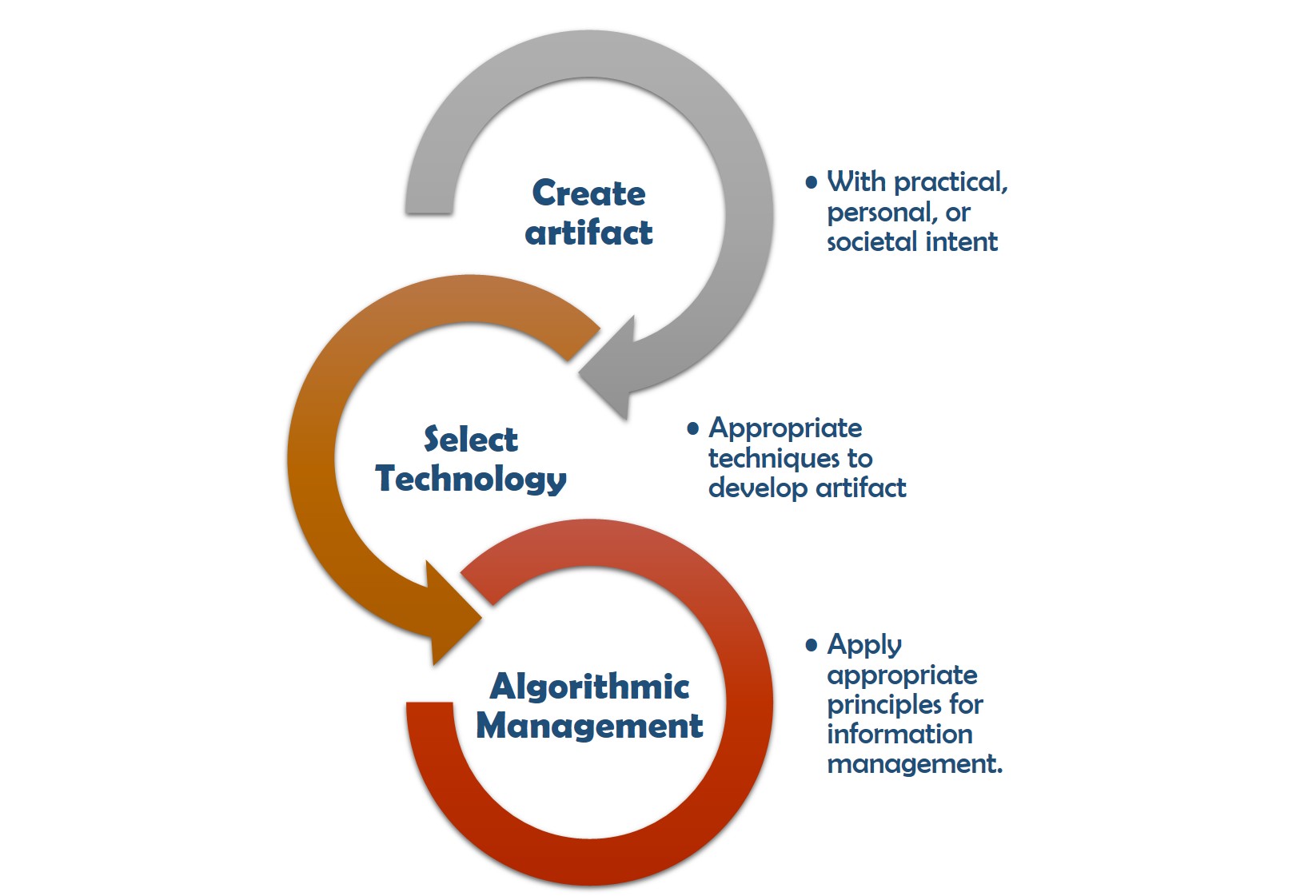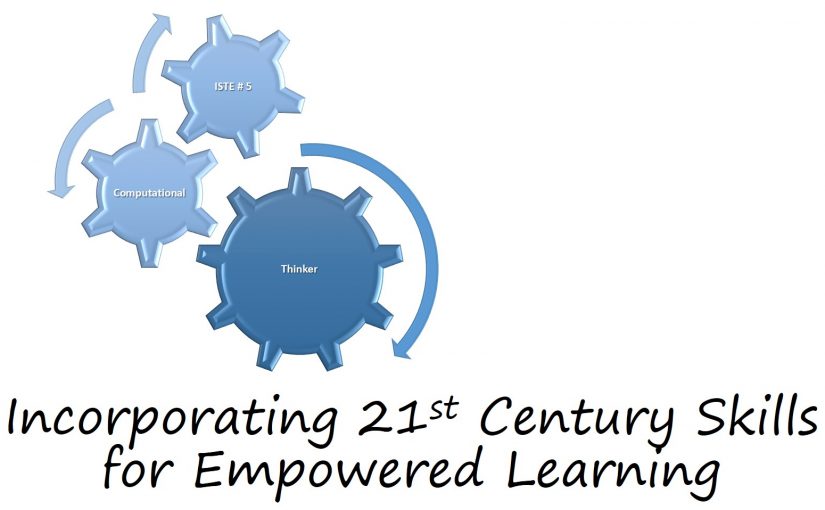Who says playing video games doesn’t teach you anything? Playing and creating games could actually help students develop another 21st century skill, computational thinking (CT). Computational thinking is a form of problem solving that takes large, complex problems, breaks them down into smaller problems, and uses technology to help derive solution. In deriving solutions, students engage in a systematic form of problem solving that involves four steps: 1) “decomposition” where a complex problem is broken down into smaller, more manageable problems, 2) “pattern recognition” or making predictions by finding similarities and differences between the broken down components, 3) “abstraction” developing general principles for the patterns that emerge, and 4) “algorithm design”, creating step-by-step instructions to solve not only this problem but other similar problems in the future, (Google School, 2016). By engaging in computational thinking, “students develop and employ strategies for understanding and solving problems in ways that leverage the power of technological methods to develop and test solutions, (ISTE, 2017). In other words, the key to successfully following this process is that students develop their own models rather than simply applied existing models, (Google School, 2016).

In researching ways to apply computational thinking in the classroom, I ran across scholarly articles discussing the gamified classroom. I have always been intrigued with this concept, from my own experience students are so much more engaged during class time when the required content is converted into a game. During these game sessions, my role changes from the the person delivering the content, to the person delivering the game (i.e. asking the questions). The students are responsible for providing the content by providing solutions to the posed questions, thereby evoking problem-solving skills and in some cases, critical thinking skills. This idea-thread then led me to think “what are some ways that a “gamified” classroom can help develop computational thinking?”
To help answer my question, I came across two articles that pinpointed models in game-design to build computational thinking:
Article 1: Yang & Chang, 2013. Empowering students through digital game authorship: Enhancing concentration, critical thinking, and academic achievement.
Yang and Chang explore how students can increase their motivation for learning when they are allowed to design their own game given a specific topic. During the game design process there is significant problem-solving that occurs because of the interaction and the immediate feedback the process entails. In addition, students gain high order thinking such as building creativity, and critical thinking. The authors mention three game building software that does not require extensive coding skills: RPG Maker, Game Maker, and Scratch. During their study, the researchers investigated the effects of game design process on seventh grade biology students that were using either Flash animation (digital flash cards) or RPG Maker. The investigated effects included concentration, critical thinking, and academic performance. Their result demonstrated that the group using the RPG maker had significant improvements on critical thinking and academic performance, while no significant difference was noted on concentration for both groups.
Article 2: Kazimoglu, et. al., 2012. A serious game for developing computational thinking and learning introductory computer programming.
Kazimoglu et. al. begin their inquiry by providing a few definitions. It is important to understand the terminology they use, mainly defining any game used for educational purposes as a “serious” game. They acknowledge that several definitions of computational thinking exist so they create their own definition that require the following elements: 1) conditional logic (true vs. false conditions); 2) building algorithms (step-by-step instructions); 3) debugging (resolving issues with the instructions); 4) simulation (modeling); and 5) distributed computation (social sharing). The authors are challenged to create a non-threatening introduction to programming unit to combat common student perception that programming is “difficult.” Kazimoglu et. al. believe that when students are allowed to engage in game design, they are motivated to learn which provokes problem solving. They take this approach to their introduction programming class where they challenge students through a series of exercises using the Robocode platform. At the end of the study, all students successfully completed the exercise, engaging in problem-solving skills.
Conclusions. Interestingly, both of these articles struggle to exactly define “computational thinking” and both mention that specific research investigating the extent to which games can develop CT is lacking. However, what both can agree on is that CT is best developed when students are the game designers. In order to do this, both studies involved elements of programming instruction to help students successfully build their games.
While these articles offer models into successfully implementing computational thinking through game design and creation, it was a little disheartening to discover that programming instruction was a necessary component. My inclination was to think how can these processes be implemented and/or adapted in other classroom scenarios particularly when programming instruction may or may not be feasible. Interestingly, not all researchers agree that programming need be involved in successful CT implementation. Voogt et. al. argue that although most research on CT involves programming, because CT is a thinking skill, it does not require programming in order to be successfully implemented, (Voogt et. al., 2015). In fact, in a literature review conducted by Voogt demonstrated that students do not automatically transfer CT skills to a non-programming context when instruction focused on programming alone. The strongest indicator of CT mastery was actually heavily dependant on instructional practices that focuses on application, (Voogt et. al., 2015).
The lack of a standard definition of computational thinking also needs to be addressed. The two articles above and the Voogt researchers agree that discrepancies exist among current definitions of computational thinking. To avoid confusion regarding the role of programming and other such technologies, computational thinking can be simply defined as a way of processing information and tasks to solve complex problems, (Voogt et. al., 2015). It is a way to look at similarities and relationships between a problem and follow a systematic process to reaching a solution. Figure 1.2 summarizes this simplified process.

According to this new context, it is not necessary to program games in order for students to build computational thinking. Allowing students to participate in systematic artifact creation will do the trick. Some examples of artifact creation without the use of programing include: remixing music, generating animations, developing websites, and writing programs. The main idea of this artifact creation process is that students follow procedures that can be applied to similar problems. Figure 1.3 highlights this artifact creation process.

How can this artifact creation process be used in creating gamified classroom? To help me explore this issue, one of my colleagues suggested allowing students to develop and design their own board game. While the solution seems low-tech, others agree with this strategy. Michele Haiken, an educational leadership for ISTE, writes about adapting “old school” games for the classroom to help develop critical thinking and problem solving skills, (Haiken, 2017). Students can even create an online “quest,” scavenger hunt, or create a “boss event” to problem-solve computationally, (Haiken, 2017). For more tech-y solutions, existing platforms and/or games such as GradeCraft and 3DGameLab can be used to apply computational thinking in a gamified classroom, (Kolb, 2015). Regardless of the method used, low-tech board games or high-tech game creation through programming, allowing students to participate in the artifact creation process helps to build computational skills that they can then apply to other complex problems to create their own models.
References
Google School, (2016). What is computational thinking? [Youtube Video]. Retrieved from: https://www.youtube.com/watch?v=GJKzkVZcozc&feature=youtu.be.
Haiken, M., (2017). 5 ways to gamify your classroom. Retrieved from: https://www.iste.org/explore/articledetail?articleid=884.
International Society for Technology in Education, (2017). The ISTE standards for students. Retrieved from: https://www.iste.org/standards/for-students.
Kazimoglu, C., et. al., (2012). A serious game for developing computational thinking and learning introductory computer programming. Procedia-Social and Behavioral Sciences, 47, 1991-1999.
Kolb, L., (2015). Epic fail or win? Gamifying learning in my classroom. Retrived from: https://www.edutopia.org/blog/epic-fail-win-gamifying-learning-liz-kolb.
Voogt J, et. al., (2015). Computational thinking in compulsory education: Toward an agenda for research and practice. Education and Technologies, 20(4), 715-728.
Yang, Y. C., & Chang, C. (2013). Empowering students through digital game authorship: Enhancing concentration, critical thinking, and academic achievement. Computers & Education, 68(c), 334–344.
